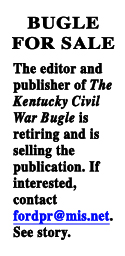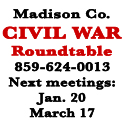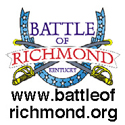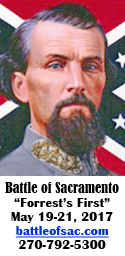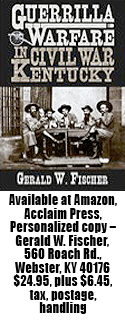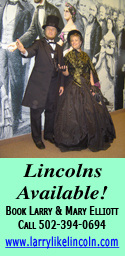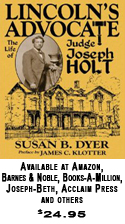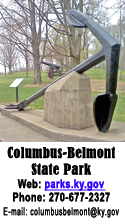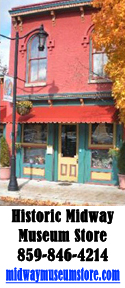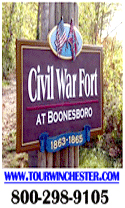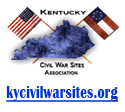 |

New Civil War sites continue to develop in Kentucky as interest in the history and heritage of America’s great conflict increases. Currently, there are more than 60 locations throughout the Commonwealth dedicated to the study, preservation and interpretation of how and what happened during the period of 1861-65.
Click map below to view and download full size map (36 inches x 22 inches).
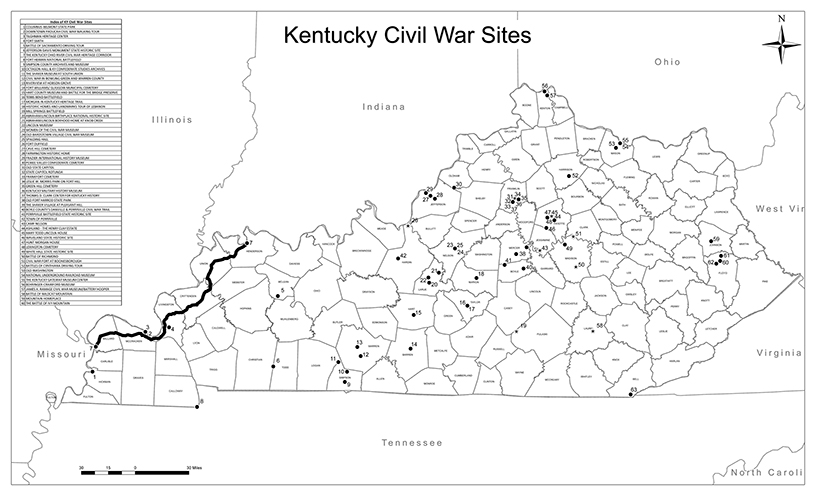
* * *
WESTERN REGION
1. COLUMBUS-BELMONT STATE PARK
www.parks.ky.gov
KY 58 and KY 123/80, Columbus 364/677-2327. This is the site of a massive chain and anchor used to block the passage of Union gunboats during the Civil War. There also is a Confederate cannon, a network of earthen trenches, and an impressive new museum in what was once a Civil War hospital. There is a small admission fee for the museum. From the Purchase Pkwy: take exit 1, US 51 north to Clinton; go northwest on KY 58 to Columbus and the park.
2. DOWNTOWN PADUCAH CIVIL WAR WALKING TOUR
Visitor’s Center, 128 Broadway, Paducah 800/723-8224. In September 1861, Kentucky’s neutrality was shattered as Confederate forces took the river town of Columbus. The Union responded by taking Paducah. A free tour brochure is available at the Visitor’s Bureau at 128 Broadway in downtown Paducah.
3. TILGHMAN HERITAGE CENTER
631 Kentucky Ave., Paducah 364/575-1870. Perhaps Paducah’s most famous Civil War son, Confederate Brig. Gen. Lloyd Tilghman, commanded Fort Henry on the Tennessee River early in the war and was killed on May 16, 1863 at the Battle of Champion’s Hill near Vicksburg, Miss. The Tilghman Home is open to the public for tours and houses an outstanding Civil War museum. Admission is charged.
4. FORT SMITH
Smithland Area Chamber of Commerce, Smithland 364/928-2446. Fort Smith, a star-shaped earthen fort, was part of a series of fortifications built by Union forces to protect the mouth of the Cumberland River. Gen. Ulysses S. Grant seized Smithland in September 1861. By 1864, the fort was manned by a detachment of African-American soldiers. The site includes the fort, trails and interpretative signage. Admission is free.
5. BATTLE OF SACRAMENTO DRIVING TOUR
www.battleofsac.com
Sacramento City Hall, 292 Main Street, Sacramento 364/736-5114. The site of Nathan Bedford Forrest’s first battle. His double goal was to protect the Confederate base and capital at Bowling Green and to control the Green River. Ten stops recreate the battle’s daring action and introduce the combat’s participants. Located five miles north of the Western Kentucky Parkway. Free driving tour brochures can be obtained at City Hall in Sacramento.
6. JEFFERSON DAVIS MONUMENT STATE HISTORIC SITE
www.parks.ky.gov
US 68, Fairview 364/886-1765. The monument is a 351-foot-high concrete obelisk that marks the site where, on June 3, 1808, Jefferson Davis was born. Ride an elevator to an observation room atop the structure for a panoramic view of the western Kentucky countryside. A fee is charged to ride the elevator.
7. THE KENTUCKY OHIO RIVER CIVIL WAR HERITAGE CORRIDOR
Henderson to Wickliffe 364/762-2231. The Kentucky Ohio River Civil War Heritage Trail is a heritage byway that will utilize 132 miles of US 60 between Henderson and Wickliffe. This route will highlight Civil War activities in western Kentucky and will encompass six counties, some 20 communities, three Renaissance cities and numerous National Register districts. Interpretive markers are placed at 32 stops along the trail and an illustrated guidebook is available.
8. FORT HEIMAN NATIONAL BATTLEFIELD
682 Fort Heiman Road, New Concord. An expansion of Fort Donelson National Battlefield near Dover, Tenn., this park preserves the remains of one of three fortifications built along the Tennessee and Cumberland Rivers by the Confederate Army. The surrender of these three forts was an early Union victory in the Civil War. For more information, contact Ft. Donelson National Park Visitor Center (931) 232-5706.
SOUTHERN REGION
9. SIMPSON COUNTY ARCHIVES AND MUSEUM
www.simpsoncountykyarchives.com
206 North College St., Franklin 364/586-4228. Confederate or Union prisoners made drawings on the plaster walls in the second story of the Old Simpson County Jailer’s Residence. The drawings depict soldiers. One looks remarkably like Confederate Brig. Gen. John Hunt Morgan. The museum includes a display on Franklin native Marcellus Jerome Clarke, best known as Sue Mundy, and one of Kentucky’s most notorious Civil War guerrillas. Admission is free.
10. OCTAGON HALL & KY CONFEDERATE STUDIES ARCHIVES
http://www.civilwar.org
6040 Bowling Green Road, Franklin 364/586-9343. The only surviving example of an octagon-shaped mansion in the Commonwealth of Kentucky. The grounds of this unique structure were utilized by elements of the famed Kentucky Orphan Brigade as an encampment site on Feb. 13, 1862. Octagon Hall is being restored to its 1859 appearance and houses an outstanding Civil War museum and Confederate Research Library. It is open to the public Wednesday thru Saturday from 8 a.m. to 3:30 p.m. Admission is free.
11. THE SHAKER MUSEUM AT SOUTH UNION
www.southunionshakervillage.com
US 68, 10 miles west of Bowling Green, South Union 364/542-4167. Scores of Civil War encampments were established within this pacifist village. Afterward, it was estimated that more than 100,000 meals had been provided to soldiers on both sides. Located 10 miles west of Bowling Green on US 68. Admission is charged.
12. CIVIL WAR IN BOWLING GREEN AND WARREN COUNTY
Visitors Center of the Bowling Green/Warren County Tourist and Convention Commission, 352 Three Springs Road, Bowling Green 364/782-0800. Eleven sites compose this driving tour of historic Bowling Green and Warren County – an area which both the Confederacy and the Union strongly wanted to control. Notably, Bowling Green served as the capital of Confederate Kentucky. Admission is charged at three of the sites.
13. RIVERVIEW AT HOBSON GROVE
http://www.bgky.org/riverview/
1100 West Main St., Bowling Green364/843-5565. Construction on this Italianate home along the Barren River was begun in the 1850s, but was halted by the Civil War. During the Confederate occupation of Bowling Green in 1861-62, the unfinished home was used as a munitions magazine.
14. FORT WILLIAMS
www.cityofglasgow.org/fortwilliams.htm
Glasgow Municipal Cemetery just off the US 31E bypass, Glasgow 364/651-5335. Following Morgan’s Christmas Raid, this fortification was constructed to guard against further invasion. Admission is free.
15. HART COUNTY MUSEUM AND BATTLE FOR THE BRIDGE PRESERVE
www.battleforthebridge.org/Preserve.html
109 Main St., Munfordville 364/524-0101. The county seat of Hart County, Munfordville was near the site of two Civil War battles, the Battles of Munfordville and Rowlett’s Station. The town also was heavily fortified and occupied by Union forces from 1862 until the end of the war. Munfordville also was home to two Civil War generals, Simon B. Buckner, CSA, and Thomas Wood, USA. The museum features Civil War memorabilia related to the battles and to the generals and also offers genealogical resources. Admission is free.
16. TEBBS BEND BATTLEFIELD
http://en.wikipedia.org/wiki/Battle_of_Tebbs_Bend
Taylor County Tourist Commission, Courthouse, Broadway and Court, Campbellsville 364/465-3786. The Battle of Tebbs Bend/Green River Bridge took place on a bend in the Green River eight miles south of Campbellsville. This was the first battle of Gen. John Hunt Morgan’s Great Indiana and Ohio Raid. A self-guided driving tour brochure of the battlefield is available at the Tourist Commission or at Green River Lake Park Interpretive Center. This battlefield is part of the Morgan in Kentucky Heritage Trail.
17. MORGAN IN KENTUCKY HERITAGE TRAIL
The American Civil War Institute, Campbellsville University – Campbellsville 364/789-5058. The Morgan in Kentucky Heritage Trail is a heritage byway that ties together episodes from the Civil War career of Confederate Gen. John Hunt Morgan utilizing U.S., state and county road systems primarily in the south central portion of the state. The trail has interpretive signs and a brochure offers in-depth information, placing the trail within a broader historic context dealing with the Commonwealth’s role in this watershed moment in American history.
18. HISTORIC HOMES AND LANDMARKS TOUR OF LEBANON
Lebanon-Marion County Chamber of Commerce, 21 Court Square, Lebanon 364/692-9594. Lebanon was the site of three Civil War battles – 1861, 1862 and 1863. The burgeoning town had grown up steadily until the war, with its railway location making it susceptible to attack. This self-guided tour is available from the Chamber of Commerce at 21 Court Square.
19. MILL SPRINGS BATTLEFIELD
www.millsprings.net
Hwy. 235, Somerset 606/679-1859. The Battle of Mill Springs was the scene of a major Union victory. This battle helped destroy the Confederate defense line in Kentucky and began a series of Confederate disasters that culminated at the Battle of Shiloh in Tennessee. The site features a nine-stop driving tour, numerous interpretive signs, two cemeteries and a mill. Admission is free.
NORTH CENTRAL REGION
20. ABRAHAM LINCOLN BIRTHPLACE NATIONAL HISTORIC SITE
www.nps.gov/abli
2995 Lincoln Farm Rd., Hodgenville 270/358-3137. This National Park Service site features the original Lincoln family farm and the spring where the Lincoln family drew water. There is also a museum. Admission is free.
21. ABRAHAM LINCOLN BOYHOOD HOME AT KNOB CREEK
www.nps.gov/abli
7120 Bardstown Rd., Hodgenville 270/358-3137. Located 10 miles northeast of the Abraham Lincoln Birthplace National Historic Site, this is the last home of the Lincoln family before they left Kentucky for Indiana. A tavern and a replica of the family cabin were constructed in the ‘30s and remain today as outdoor exhibits. The National Park Service offers limited interpretive opportunities. Site is open year around and staffed seasonally. Admission is free.
22. LINCOLN MUSEUM
www.lincolnmuseum-ky.org
66 Lincoln Square, Hodgenville 270/358-3163. The Lincoln Museum includes a wax museum that features 12 scenes from the life of Abraham Lincoln. The museum also includes an art collection, an interpretive film and a collection of Civil War memorabilia. Admission is charged.
23. WOMEN OF THE CIVIL WAR MUSEUM
www.civil-war-museum.org
204 East Broadway, Bardstown 502/349-0291. More than 400 women disguised themselves as soldiers during the Civil War. This collection portrays women as nurses, spies, soldiers and plantation and factory workers. It is within walking distance of the Old Bardstown Village Civil War Museum. Admission is charged.
24. OLD BARDSTOWN VILLAGE CIVIL WAR MUSEUM
www.civil-war-museum.org
310 East Broadway, Bardstown 502/349-0291. The War of the West is the focus here. Often underplayed in other museums, the western armies witnessed the military beginnings of famous Union generals such as Grant, Sherman and Sheridan. This museum is located two miles off the Bluegrass Parkway near downtown Bardstown. Admission is charged.
25. SPALDING HALL
114 North Fifth St., Bardstown 502/348-2999. Erected in 1826, Spalding Hall, a large, federal-style brick building, originally was part of St. Joseph’s College. Now it’s a museum, which includes a room featuring Civil War artifacts and memorabilia. Museum guides can provide information on Bardstown’s role in the Civil War. Located near downtown. Admission is free.
26. FORT DUFFIELD
www.fortduffield.com
US 31W at Salt River Dr., West Point 502/922-4574. Ft. Duffield is a Union fortification constructed in the fall of 1861 to protect the Old L&N Turnpike. One of the largest and best preserved earthwork forts in Kentucky, this site includes a self-guided tour and a cemetery. Admission is free. Handicap accessibility by appointment.
27. CAVE HILL CEMETERY
www.cavehillcemetery.com
701 Baxter Ave., Louisville 502/451-5630. One of the most beautiful cemeteries in Kentucky. Both Confederate and Union troops, including three Union generals, are interred here. There also are several commemorative monuments. Admission is free.
28. FARMINGTON HISTORIC HOME
www.farmingtonhistoricplantation.org
3033 Bardstown Rd., Louisville 502/452-9920. An early 19thcentury plantation with a unique Federal style highlights the Speed family who built the house in 1816. This house was constructed following plans by Thomas Jefferson. Plantation life from 1812 through the Civil War is interpreted here. The original owner’s son, Joshua Fry Speed, was a close friend of Abraham Lincoln, and his brother, James Speed, served as Lincoln’s Attorney General. Plantation life, the institution of slavery and the lives of African-Americans who lived on the farm, and Lincoln’s connections are all explored and interpreted here through the exhibits and programs. Admission is charged.
29. FRAZIER INTERNATIONAL HISTORY MUSEUM
www.fraziermuseum.org
829 West Main St., Louisville502/753-5663. A 100,000-square-foot facility on three floors, the Frazier lets visitors experience the stories of Americans and international generals, heroes and famous leaders whose military victories and defeats changed the world.
30. PEWEE VALLEY CONFEDERATE CEMETERY
Maple Avenue, Pewee Valley 800/813-9953. The cemetery for the Kentucky Confederate Home. This site marks the final resting place for more than 300 Confederate veterans. Located on the south side of Maple Avenue just south of the intersection with Old Floydsburg Rd. in Pewee Valley.
31. OLD STATE CAPITOL
capitol.ky.gov/Pages/default.aspxl
Broadway and Lewis St., Frankfort 502/564-3016. The only loyal state capitol captured by Confederate troops. A Confederate governor was inaugurated here during the 1862 invasion of Kentucky. Admission is free.
32. STATE CAPITOL ROTUNDA
capitol.ky.gov/Pages/default.aspx
700 Capitol Ave., Frankfort 502/564-3449. Within the rotunda of Kentucky’s new state capitol are the statues of prominent Kentuckians, including a bronze Abraham Lincoln by B.A. Weinmanand a marble Jefferson Davis by Frederick C. Hibbard. Admission is free.
33. FRANKFORT CEMETERY
215 East Main St., Frankfort 502/227-2403. Located on a bluff above the Kentucky River, Frankfort Cemetery is the final resting place for numerous Civil War soldiers.
34. LESLIE W. MORRIS PARK ON FORT HILL
Frankfort 800/960-7200. This Civil War site is where local militia held off an attack by Confederate cavalrymen attempting to destroy the capital city. The walls of Fort Boone still stand, as do the earthworks of a second fort known as the New Redoubt. A walking tour brochure leads visitors through the forts, the 1864 skirmish site, and a portion of the park’s 150 acres of forests and meadows. Panoramic view of historic downtown Frankfort. Admission is free.
35. GREEN HILL CEMETERY
East Main St., Frankfort 899/960-7200. Features the only memorial in the state to Kentucky’s African-American soldiers.
36. KENTUCKY MILITARY HISTORY MUSEUM
www.history.ky.gov
East Main St. at Capitol Ave., Frankfort 502/564-3016. Located in the historic 1850 State Arsenal, the Kentucky Military History Museum includes a large collection of Kentucky Confederate memorabilia, including uniforms, flags, guns, and other weapons. An extensive research collection related to the war also is housed here. Admission is free.
37. THOMAS D. CLARK CENTER FOR KENTUCKY HISTORY
www.history.ky.gov
100 West Broadway, Frankfort 502/564-1792. The Thomas D. Clark Center for Kentucky History is a 167,000-square-foot state-of-the-art museum and research facility. It’s home to the Kentucky Historical Society and features a variety of temporary and permanent exhibits that highlight and interpret 12,000 years of Kentucky’s history, including the pivotal Civil War and its aftermath in the state.
38. OLD FORT HARROD STATE PARK
www.parks.ky.gov
Lexington and College Streets, Harrodsburg 859/734-3314. This state park includes a brick pavilion that encloses the Lincoln Marriage Temple, the cabin where the parents of President Abraham Lincoln were wed on June 12, 1806. There also is a display of Civil War relics in the Mansion Museum. Admission is charged.
39. THE SHAKER VILLAGE AT PLEASANT HILL
www.shakervillageky.org
3501 Lexington Rd., Harrodsburg 800/734-5611. A restored living history museum that interprets the lives of the Shakers. This religious community was located on one of the main routes through Kentucky. Both Union and Confederate soldiers stopped and partook of the Shakers’ well-known hospitality. The Shakers were strong Unionists and very anti-slavery. Admission is charged.
40. BOYLE COUNTY’S DANVILLE & PERRYVILLE CIVIL WAR TRAIL
Visitor’s center, 304 S. Fourth Street, Danville 800-755-0076. Boyle County experienced the horrors of the Civil War more than any other Kentucky county. It endured several cavalry raids, a shootout in downtown, a guerilla raid, and the Commonwealth’s largest battle. A free tour brochure is available at the visitor’s center in downtown Danville.
41. PERRYVILLE BATTLEFIELD STATE HISTORIC SITE
www.perryvillebattlefield.org
Hwy. 1920, Perryville 859/332-8631. Kentucky’s largest Civil War battle raged around the village of Perryville on Oct. 8, 1862. It was the Confederacy’s last attempt to take possession of Kentucky. The site features a 300-acre battlefield and a museum featuring artifacts and displays related to the battle. Admission is charged for the museum.
42. TOWN OF PERRYVILLE
US 68 and US 150, Perryville 859/332-1862. Perryville is a small hamlet in central Kentucky. The old Merchants Row along old US 68 features structures that appear as they did in 1862. The town has numerous buildings that date from the Civil War.
43. CAMP NELSON
www.campnelson.org
Off US 127, six miles south of Nicholasville 859/881-9126. Camp Nelson was a major Union quartermaster depot for the armies of the Ohio and Cumberland. From this base, Union forces carried out operations against Knoxville, Tenn., and Saltville in southwest Virginia. More than 10,000 African-American soldiers were recruited here, making it the third largest recruiting base for black soldiers in the Civil War. The park includes walking trails, guided tours of the restored Perry Mansion and earthen fortifications. All are located next to the National Military Cemetery.
44. ASHLAND - THE HENRY CLAY ESTATE
www.henryclay.org
120 Sycamore Rd., Lexington 859/266-8581. Ashland was the estate of Henry Clay, from 1811 until his death in 1852. Clay was one of the most important politicians of the 19th Century. He served as U.S. Senator, Speaker of the House, Secretary of State, and he ran for president three times. He was the chief author of the Compromise of 1850, which helped hold the Union together. Admission is charged.
45. MARY TODD LINCOLN HOUSE
www.mtlhouse.org
578 West Main St., Lexington 859/233-9999. The wife of the 16th President, Abraham Lincoln, lived in this brick house for seven years. After the two were married, they visited the house, whose collection includes articles from both the Todd and Lincoln families. Admission is charged.
46. WAVELAND STATE HISTORIC SITE
www.parks.ky.gov
225 Waveland Museum Lane, Lexington 859/272-3611. Both Confederate and Union armies prized the Standardbred horses raised on this plantation, which primarily grew tobacco and hemp. This house museum offers interpretation of the everyday antebellum life of the Bryan family. Located south of Lexington on US 27. Admission is charged.
47. HUNT-MORGAN HOUSE
www.cr.nps.gov/nr/travel/lexington/hun.htm
201 North Mill St., Lexington 859/233-3290. A Federal-style home built in 1814, it was later the home of Gen. John Hunt Morgan and Nobel Prize recipient, Thomas Hunt Morgan. This house museum includes period furnishings and a second-floor Civil War museum. Admission is charged.
48. LEXINGTON CEMETERY
www.lexcem.org
833 West Main St., Lexington 859/255-5522. A self-guided tour is available for the historical portion of the cemetery. There are at least seven Civil War generals buried in this cemetery, which also includes the graves of numerous soldiers from both sides. The cemetery also boasts two monuments to the Confederacy.
49. WHITE HALL STATE HISTORIC SITE
www.parks.ky.gov
500 White Hall Shrine Rd., Richmond 859/623-9178. White Hall’s owner, Cassius Marcellus Clay (the Lion of White Hall), was a friend of Abraham Lincoln. Clay was an outspoken emancipationist and newspaper editor. He received a commission as a Union general and later served as minister to Russia. The mansion, built in the Italianate style, includes period furnishings. Admission is charged.
50. BATTLE OF RICHMOND
www.battleofrichmond.org
101 Battlefield Memorial Highway, Richmond 859/248-1974. The Battle of Richmond was one of the most decisive Confederate victories of the Civil War and the second largest battle in the Commonwealth. This lopsided battle was part of the 1862 Confederate invasion of Kentucky. A Visitors and History Center and Battlefield Park are open to the public.
51. CIVIL WAR FORT AT BOONESBOROUGH
www.tourwinchester.com
Winchester/Clark County Tourism, 2 Maple Street, Winchester 859/744-0556. Controlling access to the major crossing points on the Kentucky River became an important part of the strategy of the Union Army in late 1862 and early 1863. The Civil War Fort at Boonesborough is an example of a redoubt, an enclosed earthen fort that was surrounded by a ditch and was constructed in the spring of 1863 to protect the crossings at Clays Ferry and Tates Creek.
52. BATTLES OF CYNTHIANA DRIVING TOUR
117 Court St., Cynthiana 859/234-5236. Two of Confederate Gen. John Hunt Morgan’s raids came through this central Kentucky town. The first raid was in 1862, where fighting centered on downtown, and the second in 1864, which resulted in three separate fights. A free, self-guided driving tour brochure is available at the Cynthiana/Harrison County Chamber of Commerce.
53. OLD WASHINGTON
www.washingtonky.com
2215 Old Main St., Washington 606/759-7411. Old Washington was an important early settlement in Kentucky. Several Civil War-related sites include: the birthplace of Confederate Gen. Albert Sidney Johnston; the Methodist Episcopal Church South; and the Paxton Inn, believed to be an Underground Railroad site. Old Washington also was the site of a slave auction that inspired the writing of Harriet Beecher Stowe’s Uncle Tom’s Cabin. Admission is charged.
54. NATIONAL UNDERGROUND RAILROAD MUSEUM
www.cityofmaysville.com
115 East Third St., Maysville 606/564-6986. Perhaps one of the most misunderstood and important features of the abolitionist movement, the Underground Railroad helped thousands of slaves escape from bondage in the South. This museum includes artifacts and memorabilia related to this clandestine operation committed to the emancipation of slaves. Admission is charged.
55. THE KENTUCKY GATEWAY MUSEUM CENTER
www.cityofmaysville.com
215 Sutton Street, Maysville 606/564-5865. With economic ties to the free and neighboring North, and cultural ties to the slave-holding South, this picturesque town on the Ohio River was naturally divided throughout the Civil War. A permanent exhibit and part of a film shown here offer a significant glimpse at the region’s Civil War heritage. Admission is charged.
56. BEHRINGER-CRAWFORD MUSEUM
www.bcmuseum.org
1600 Montague Rd., Covington 859/491-4003. Covington’s Behringer-Crawford Museum is located in the old Devou family home in the 700-acre Devou Park. The museum’s collections cover all periods of the region’s history, including a fine display of Civil War artifacts. An extant Civil War fort, Battery Bates, is located in the park. Admission is charged.
57. JAMES A. RAMAGE CIVIL WAR MUSEUM/BATTERY HOOPER
www.fortwright.com
1402 Highland Ave., Fort Wright 859/344-1145. Built on the site of one of the few remaining Civil War entrenchments that protected Cincinnati during the 1862 Confederate invasion of Kentucky, the museum preserves and interprets the area’s role in the Civil War as well as the history of the city of Ft. Wright through archaeology, education and research.
EASTERN REGION
58. BATTLE OF WILDCAT MOUNTAIN
www.fs.fed.us/r8/boone/districts/london/wildcat.shtml
London/Laurel Co. Tourist Commission, 80W & I-75, exit 41, London 800/348-0095. The October 1861 Battle of Wildcat Mountain was the earliest major Civil War battle, as well as the first Union victory, in Kentucky. This was part of CSA Gen. Felix Zollicoffer’s Mill Springs campaign. Some monuments have been erected and walking trails are being developed within this scenic, rough terrain that is home to varied flora and fauna. Admission is free.
59. MOUNTAIN HOMEPLACE
www.mountainhomeplace.com
Staffordsville (outside of Paintsville) 606/297-1850. A Civil War era farm, Mountain Homeplace is a living history park that interprets Johnson County from 1850-1875. The park includes several historic buildings that have been reconstructed on the site. An interpretive video details the role of Kentucky’s mountains during the Civil War. Admission is charged.
60. THE BATTLE OF IVY MOUNTAIN
www.nps.gov/abpp/battles/ky003.htm
Hwy 23, Ivel, Prestonsburg Tourism Commission 606/886-1341. In the Fall of 1861, Gen. William Nelson, Union Commander in northeastern Kentucky, was ordered to break up a large recruiting camp in Prestonsburg. In what would be the first major clash in Eastern Kentucky, Confederate Capt. Andrew Jackson May’s recruits would take up positions at this site, where they waited in ambush. The Battle of Ivy Mountain ended the first phase of the struggle for the Big Sandy Valley. Admission is free.
61. SAMUEL MAY HOUSE
www.mayhouse.org
Friends of the Samuel May House, Prestonsburg 800/844-4704. The May House in North Prestonsburg, built in 1817, is the oldest brick home in the Big Sandy Valley. A century ago, it was the hub of a 300-acre farm and in the summer of 1861, the big meadow below the house became the site of the largest Confederate recruiting camp in the region. Tours by appointment only.
62. MIDDLE CREEK NATIONAL BATTLEFIELD
www.middlecreek.org
Prestonsburg 606/886-1312. Located on Route 114 in Floyd County, the Middle Creek Battlefield was a tragic example of the fratricidal, neighbor-against-neighbor warfare that characterized the struggle for Kentucky. The battle also was a testing-ground on which reputations were made and lost. Here, James A. Garfield launched a military career that eventually led to the Presidency of the United States. The site contains walking trails that are fully equipped with interpretive signs that enable the visitor to better understand the importance of this site and contributions made by eastern Kentuckians to the nation during the terrible years of the Civil War. Admission is free.
63. CUMBERLAND GAP NATIONAL HISTORICAL PARK
www.nps.gov/cuga
US 25E South, Middlesboro 606/248-2817. Cumberland Gap is the historic mountain pass on the Wilderness Road that opened Kentucky to westward migration. During the Civil War, Cumberland Gap remained an important route into Kentucky. Both sides fought over the gap and fortified it. The remains of those earthworks can still be seen. Admission is free.
Articles and photos appearing on www.thekentuckycivilwarbugle.com may be used with permission. For permission, contact Bugle editor Ed Ford at fordpr@mis.net.
Back to top
Back to top
